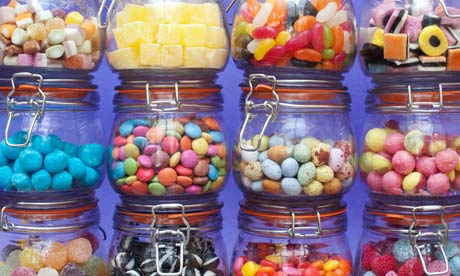
This government, like the last one, is apt to worry about Britishness. What is it, and how does one acquire it? Well, here's my idea: sweets. (I mean sweets as in sweeties, not puddings: honestly, you really should read your Nancy Mitford.) Is there any nation in the world that loves sweets more than we do? No. So why doesn't the Home Office incorporate them into the citizenship exam? Questions could be asked about how much the Pink Panther strawberry bar cost, or why Opal Mints suddenly became Pacers and developed green stripes.* New arrivals to Britain could be given a bag containing key items from the sweetie canon to get them started: a Black Jack and a Fruit Salad; one item featuring sherbet and another starring liquorice; a Curly Wurly (we must nod to toffee and Toffos, alas, have ceased production); and a lolly, preferably one manufactured by Swizzel-Matlow of Derbyshire.
Sweets have been on my mind ever since I was sent The Great British Tuck Shop by Steve Berry & Phil Norman, a book with which I'm mildly obsessed. Yes, the authors left scampi Nik Naks out of the corn snack section, and failed to mention the Jelly Tots spin-offs.** But otherwise, the research is superlative. What could have been a dreary nostalgia trip – "Do you remember Spangles?" – is in fact a magisterial work of social history. Sweets, just as much as anything, tend to reflect who we are at any given moment. In 1956, for instance, Mackintosh brought a chocolate selection called Weekend on to the market. Weekend's popularity was hardly a surprise. The most striking thing about the chocolates and candies beneath its cardboard lid was their bright colour: lime green fondant, hot pink coconut ice, bright orange jelly. In a glance, the box celebrated both the end of sugar rationing (in 1953) and the rise of the Technicolor motion picture.
Weekend finally disappeared in 1988, the year I went to university. I know this because they were my mother's favourite. Like any British person who was not brought up in Totnes with only mung beans for company, I can measure out my life in confectionery. A trip to my maternal grandmother meant boiled fruit sweets and Murray Mints. A trip to my paternal grandmother meant 50p to spend on a bag – pink striped – of whatever we wanted. I always got Parma violets, Mattock's Drumsticks, and a Sherbet Fountain. A weekend at my dad's meant a trip to the Castle Market, where he would buy me a quarter of aniseed balls, a treat I could make last a whole week. Shopping with my mother could sometimes end in the purchase of Fry's Five Centres (RIP). At school, I would buy Wham bars; swotting for O-levels, I would always have a bag of strawberry and lemon bon bons on my desk in the city library. At university, marking exam papers for cash in the long vacation, I ate a Caramac every day for a month. Even now, I'm always on the look out for the perfect sweet shop, especially on mini-breaks. I like the one in Pateley Bridge, supposedly the oldest in Britain (est. 1827), which has jars on every wall. I buy liquorice comfits.
These days, we like to praise the new British food: the curd cheese we found at the farmer's market, the marsh-reared lamb we ate in an artfully distressed pub. But there's something just as great about our sweets, for all that they rot your teeth. The slightly crazed dedication involved in coming up with confectionery that will catch the eye; the skill involved in making sure your idea will survive the journey from factory to newsagent to mouth. Making honeycomb is, as Berry and Norman point out, perfectly easy: just add baking powder to hot sugar. But try to cut it, and you'll end up with lumps. When J S Fry first tried to develop the Crunchie, there were women whose job it was to solder the snapped bars back together with bunsen burners. Eventually, though, they worked it out, cutting the slabs with a jet of oil. The Crunchie was launched in 1929 and, in certain situations, it hits the spot better than the creamiest cheese, better than the pinkest lamb.
* Pink Panther bars cost 2p. Opal Mints became Pacers and got their go-faster stripes in 1976, about the time David Wilkie won Olympic gold in the 200m breast stroke. Pacers were a stalwart of local authority swimming pool vending machines. Yes, a sporty sweetie.
** The Jelly Tots spin offs were Candy Tots (like dolly mixtures), Tiger Tots (wannabe Liquorice Allsorts), and Teddy Tots (fondant cubes with a crunchy shell). They disappeared in the late 80s.

